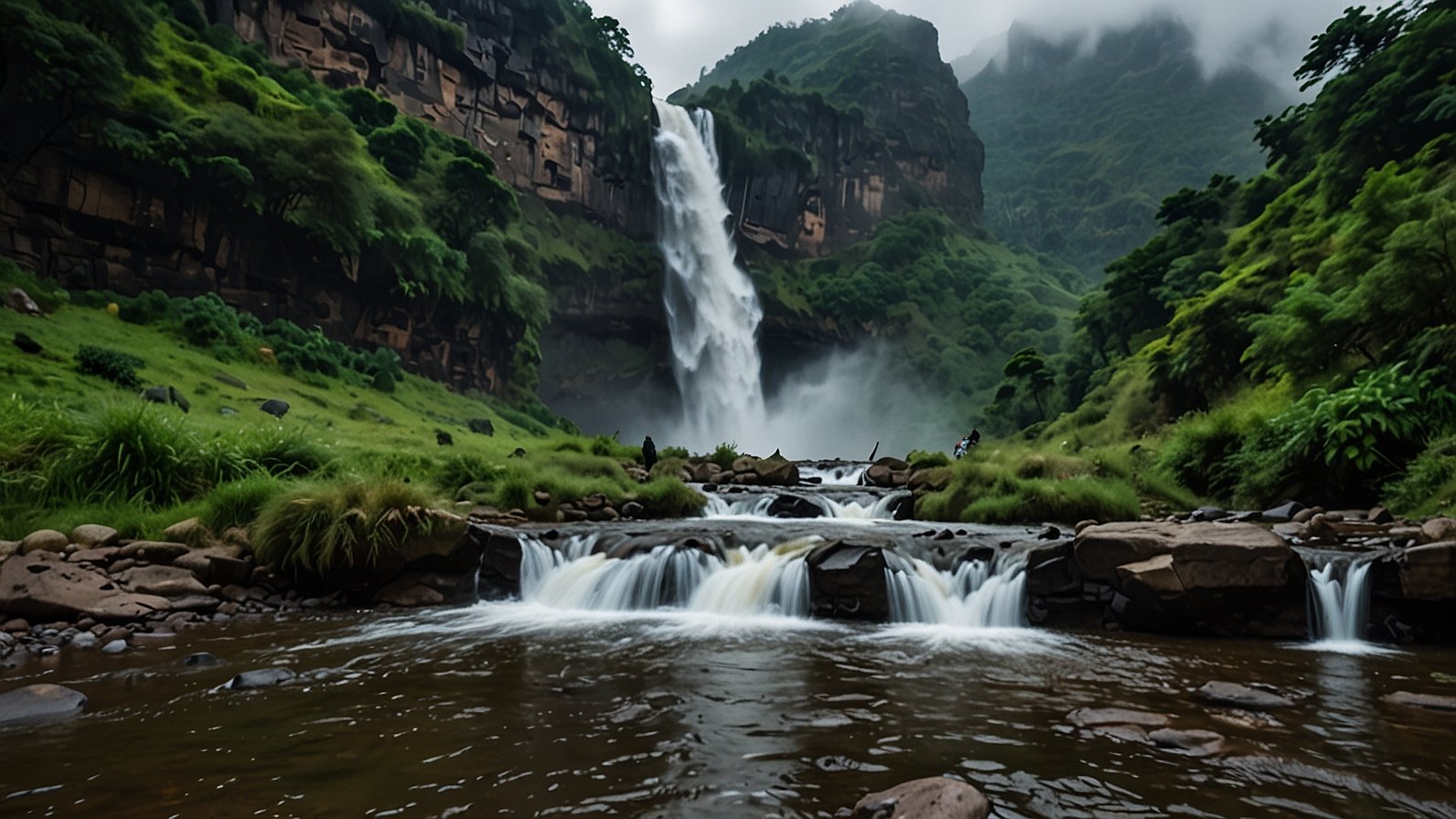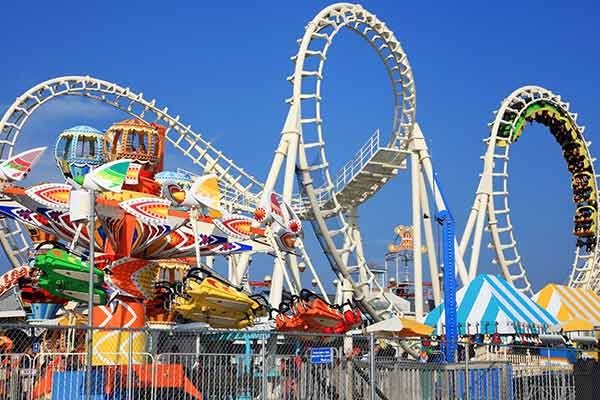Picture this: The Western Ghats, drenched in relentless monsoon rain. The air hangs thick, cool, and smells of wet earth and petrichor. Somewhere high up in the mist-shrouded Harishchandragad hills, countless streams gather momentum. They converge, gather force, and then – whoosh – they leap into the void. That raw, untamed spectacle is Kalu Waterfall, Malshej Ghat’s seasonal superstar and an adventure that etches itself onto your soul. Forget gentle cascades; this is nature flexing, a roaring, plummeting giant often whispered to be around 1,200 feet tall – making it one of the region’s most jaw-dropping vertical drops. But here’s the kicker: You can’t just show up any time. Kalu is a fleeting, monsoon-fueled dream, demanding respect and the right approach.
Honestly? The sheer scale when you finally stand before it… it’s humbling. Trekking to Kalu Waterfall isn’t just a walk; it’s an entry into what locals reverently call “God Valley.” Primarily accessed from the humble village of Khireshwar, it draws thrill-seekers and nature lovers from Mumbai and Pune like moths to a flame during the July to October window. Yet, beneath that breathtaking beauty lies a potent truth: Kalu is powerful, potentially hazardous, and entirely seasonal. Every year, local reports surface of trekkers needing rescue – a stark reminder that this adventure demands experienced guides, proper preparation, and a hefty dose of caution. Let’s dive into why this ephemeral giant should be on your monsoon bucket list, and crucially, how to experience it safely.
Why Kalu Waterfall Captivates: More Than Just Height
Sure, the ~1,200 ft figure gets thrown around a lot when talking about Kalu Waterfall’s height. Is it scientifically verified down to the last foot? Maybe not universally. Does that matter when you’re craning your neck upwards, watching water vaporize into mist hundreds of feet above before the main column even hits the rocks? Not one bit. The perception of immense height is undeniable.
- The God Valley Effect: The trek route itself, often dubbed the God Valley trail, sets the stage. You navigate through lush, rain-forest like terrain, cross bubbling streams, and traverse rocky paths. The anticipation builds with every step. Then, the valley opens up, and Kalu reveals itself – often partially veiled in mist, adding to its mystique. It feels primal, untouched.
- Pure Monsoon Magic: Kalu is the embodiment of the Maharashtra monsoon at its most dramatic. In peak flow (September-October is often prime), it’s a thundering beast. The sound is a constant, low roar that vibrates in your chest. The spray can drench you from hundreds of feet away, creating perpetual rainbows when the sun peeks through. It’s photogenic? Understatement. It’s iconic.
- The Adventure Quotient: Let’s be real, this isn’t a paved path to a viewpoint. The Khireshwar to Kalu trek involves real trekking. Scrambling over boulders, navigating potentially slippery sections (especially near the final approach), crossing streams that can swell quickly – it’s an engaging, physical experience. That effort makes the final reveal infinitely more rewarding. You feel like you’ve earned that view.
Kalu Waterfall: Seasonal Beast or Year-Round Trickle? Understanding the Rhythm
This is non-negotiable: Kalu Waterfall is a seasonal phenomenon. Trying to visit outside its window is, frankly, a recipe for disappointment and potentially increased risk due to dry, loose terrain.
| Kalu Waterfall: Monsoon Majesty vs. Off-Seon Reality | ||
|---|---|---|
| Peak Season (July-Oct) | Off-Season (Nov-June) | |
| Flow | Thunderous, full-force cascade; immense volume; powerful roar. | Reduced to a trickle or completely dry; significantly less impressive. |
| Scenery | Lush, vibrant green valleys; misty, dramatic atmosphere; vibrant streams. | Drier, browner landscape; exposed rock faces; less vibrant. |
| Trekking | Slippery, muddy paths; strong stream crossings; challenging but rewarding. | Dry, dusty, and rocky; potentially loose scree; less engaging. |
| Accessibility | Final approach can be very slippery/wet; strong currents near base. | Physically easier to approach the base, but falls are minimal. |
| Experience | High adventure, raw power, unforgettable spectacle. | Disappointing for waterfall seekers; better for general hiking. |
The Sweet Spot: While July kicks things off, the absolute best time for that perfect combination of strong flow and slightly more manageable conditions is usually mid-September to late October. The initial monsoon fury has often settled, paths might be marginally less slippery (though still treacherous), and the volume remains spectacular. Early July can be overwhelmingly wet and the paths extremely mucky, while November sees a rapid decline.
The Adventure Awaits: Trekking to Kalu Waterfall (Safely!)
The journey starts at Khireshwar village, the established gateway for the Kalu Waterfall trek. You’ll typically find basic amenities here – maybe a small stall for water or snacks, but come prepared.
- The Initial Walk: The path begins gently, often through farmland and open areas near the village, offering views back towards the valley. It sets a deceptively easy tone.
- Entering God Valley: Soon, you dip into denser forest cover. This is where the “God Valley” feel intensifies. The path narrows, follows a stream (which you’ll likely cross multiple times), and starts to involve more rock-hopping and minor ascents. The air gets cooler, damper.
- The Build-Up: As you progress deeper, the sound of Kalu starts to murmur, then growl. The valley walls rise around you. The path becomes more rugged, often requiring careful footing on wet rocks and earth. This is where good trekking shoes are worth their weight in gold.
- The Final Approach & Viewpoints: The last stretch before the main plunge pool viewpoint involves navigating potentially steep, rocky, and very slippery sections, especially after recent rain. Extreme caution is paramount here. There might be ropes fixed by guides or previous groups, but don’t rely solely on them. The main viewpoint offers a breathtaking frontal view of the entire drop. More adventurous (and only highly experienced/guided) groups sometimes venture closer to the base or explore different angles, but this significantly increases risk.
The Safety Imperative: This Isn’t Optional
Look, I get the allure of going solo. But Kalu’s beauty masks real dangers, especially during peak flow:
- Slippery Terrain: Rocks, mud, moss – everything is slick. One misstep can lead to a serious fall.
- Flash Floods & Rising Streams: Streams you crossed easily in the morning can become impassable torrents after a heavy downpour upstream. Weather changes fast in the ghats.
- Rockfalls: Erosion is constant; loose rocks can dislodge, especially on steeper sections near the falls.
- Getting Lost: While the main path is established, mist can descend rapidly, and side trails can be confusing.
- Strong Currents: The plunge pool and streams near the base have powerful undercurrents. Wading is extremely dangerous.
The Non-Negotiable Solution: Hire a Local Guide or Reputable Trekking Group. Seriously. Do it. Experienced guides from Khireshwar or organised groups from Mumbai/Pune:
- Know the safest, most current routes.
- Understand weather patterns and stream behavior.
- Carry basic first-aid and communication equipment.
- Can assess group ability and turn back if conditions deteriorate.
- Provide invaluable local knowledge and context.
Ignoring this advice? That’s how those “local reports of rescue incidents” happen. Don’t be a statistic. Prioritise safety to enjoy the spectacle.
Gearing Up for the God Valley: What You Absolutely Need
Packing wrong for Kalu can turn an adventure into an ordeal. Trust me, I’ve seen enough people struggling in flimsy sneakers. Essentials include:
- Sturdy Trekking Shoes: Waterproof with excellent grip (think Vibram soles) are ideal. No sandals, no flimsy sports shoes.
- Quick-Dry Clothing: You will get wet, from rain, spray, or sweat. Cotton becomes heavy and cold. Synthetic or merino wool is best.
- Waterproof Backpack & Rain Cover: Protect your essentials (phone, camera, dry clothes, food).
- Hydration: At least 2-3 liters of water. Rehydration salts/sachets are a good idea.
- Energy Food: Nuts, dried fruit, energy bars, chocolates. Pack lunch if not provided by a group.
- Basic First-Aid Kit: Band-aids, antiseptic, painkillers, blister plasters.
- Protection: High-SPF waterproof sunscreen, lip balm, insect repellent, sunglasses (if sunny), hat/cap.
- Safety: Whistle, headlamp/torch (even for day treks – delays happen), fully charged power bank.
- ID & Emergency Cash: Keep it in a waterproof pouch.
- (Optional but Recommended): Trekking poles for stability, a quick-dry towel, a waterproof phone case or dry bag, a small garbage bag (pack it in, pack it out!).
Beyond the Falls: Malshej Ghat’s Monsoon Palette
While Kalu is the star attraction, Malshej Ghat during the monsoon is a wonderland. If time allows, consider:
- Other Cascades: Explore smaller, often unnamed waterfalls tumbling down cliffs everywhere you look.
- Birdwatcher’s Paradise: Malshej is famous for flamingos (yes, really!) arriving at the backwaters later in the season, and numerous endemic bird species. Keep binoculars handy.
- Harishchandragad Fort: For the truly adventurous, the historic Harishchandragad fort offers challenging treks with incredible views. Requires separate planning and more time.
- Scenic Drives & Viewpoints: Simply driving through the ghats, stopping at viewpoints like Konkan Kada (though access might require trekking), is mesmerizing.
Kalu Waterfall: An Experience Etched in Mist
Kalu Waterfall isn’t just a place; it’s a feeling. It’s the adrenaline rush of the trek, the awe of standing before such raw power, the smell of wet earth and wild ginger, the sound of a million gallons of water crashing down. It’s a testament to the fleeting, dramatic beauty of the Maharashtra monsoon.
But remember its nature: powerful, seasonal, and demanding respect. Chasing this ephemeral giant requires preparation, the right gear, and crucially, experienced guidance. Don’t underestimate the terrain or the elements. Book with a reputable trek operator from Mumbai or Pune, choose the September-October sweet spot, pack smart, and embrace the adventure safely.
Witnessing Kalu in full flow is more than just ticking off a waterfall; it’s connecting with the untamed heart of the Western Ghats. Are you ready to answer the call of God Valley this monsoon?
You May Also Read: Exclusive Luxury India Tour Packages for Unforgettable Journeys
FAQs
When is the absolute best time to visit Kalu Waterfall?
The prime window is mid-September to late October. The monsoon is established, providing powerful flow, but the initial extreme downpours have often lessened, making paths slightly (though still very) challenging. July and August offer maximum water but also maximum mud and higher stream crossing risks. Avoid November onwards as the flow diminishes rapidly.
How difficult is the Kalu Waterfall trek?
It’s considered moderate to difficult, primarily due to conditions, not sheer distance. The ~3-4 km (one way) route involves uneven terrain, multiple stream crossings, rocky ascents/descents, and crucially, very slippery surfaces during the monsoon. Fitness and surefootedness are essential. The final approach is particularly steep and treacherous.
Is a guide mandatory for the Kalu trek?
While not legally enforced, hiring a local guide or joining a reputable trekking group is strongly, strongly recommended – verging on essential for safety. They navigate slippery paths, assess stream crossings, understand weather changes, and know rescue protocols. Numerous incidents highlight the risks of going unprepared and unguided.
Can I swim in the Kalu Waterfall plunge pool?
Swimming is extremely dangerous and strongly discouraged. The currents near the base are powerful and unpredictable, even if the surface looks calm. Rocks are slippery, and the force of the falling water creates hazardous conditions. Enjoy the view from a safe distance.
What are the main safety risks at Kalu Waterfall?
Key risks include: Slipping on wet rocks/mud leading to falls, flash floods causing sudden rises in streams, getting caught in strong currents near the falls, potential rockfalls from saturated cliffs, and getting lost if mist descends or straying from the path. Weather changes rapidly in the ghats.
How do I get to the starting point at Khireshwar village?
Khireshwar is accessible by road, roughly 5-6 hours drive from Mumbai and 4-5 hours from Pune. The final approach involves narrow ghat roads. Most trekking operators arrange transport from major cities. Self-driving requires caution, especially during monsoon. Public transport exists but involves multiple changes and is less convenient.
Are there any accommodation options near Kalu Waterfall?
Basic homestays or very simple lodges might be found in Khireshwar village. Most trekkers opt for day trips originating from Mumbai/Pune or stay in slightly larger towns in Malshej Ghat like Malshej (with resorts/hotels) and commute to Khireshwar for the trek start. Booking ahead in monsoon is wise.











